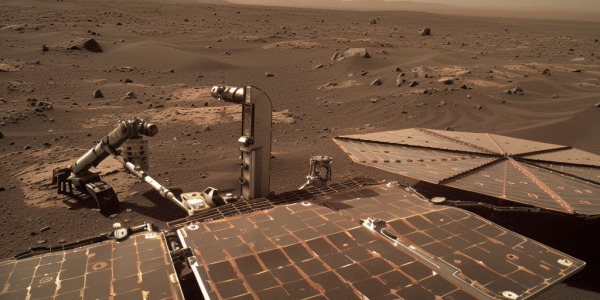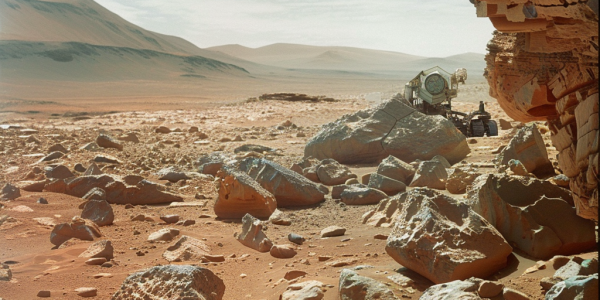Solar Orbiter Observes Active Patch on Sun, Implications for Solar Physicists
Solar Orbiter’s recent observation of an active patch on the Sun has significant implications for solar physicists in understanding the source regions of the solar wind. The spacecraft’s high-resolution images provide valuable insights into the Sun’s activity, shedding light on the connection between active regions, solar flares, and the generation of the ‘slow’ solar wind. Groundbreaking research led by Stephanie Yardley from Northumbria University utilized Solar Orbiter’s instruments to image an active region on the Sun and directly measure the slow solar wind, offering a novel approach for studying solar phenomena.
NASA’s Juno Spacecraft Discovers Jupiter’s Mysterious Fifth Moon, Amalthea
NASA’s Juno Spacecraft recently made an intriguing discovery during its 59th close flyby of Jupiter – the mysterious fifth moon known as Amalthea. Juno captured remarkable images of Amalthea as it transited Jupiter’s Great Red Spot, providing researchers with a rare glimpse of this small but fascinating natural satellite. Despite being overshadowed by Jupiter’s more prominent moons, Amalthea’s recent sighting has reignited interest in its enigmatic properties.
Retired InSight Lander Found Covered in Dust on Mars
NASA’s Mars Reconnaissance Orbiter has discovered the InSight lander slowly being covered by desert dust on the Martian surface. The defunct lander, which concluded its mission in December 2022, provided valuable insights into Mars’ geology. By monitoring the rate of dust accumulation, scientists can estimate the age of surface features and uncover artifacts from past missions, highlighting humanity’s ongoing exploration of the Red Planet.
NASA Prepares for Moon Return with Arizona Desert Tests
NASA is actively preparing for a return lunar visit by conducting tests in the Arizona desert to simulate the lunar environment. The ultimate goal is to establish a Moon base and accelerate the process of sending humans to Mars. Key preparations include constructing a Moon base and a railway station on the lunar surface, focusing on scientific exploration and international collaboration. Astronauts are honing their skills through moonwalk simulations in Arizona, utilizing augmented reality technology to navigate the moon’s South Pole region.
Lego Releases Milky Way Galaxy Wall Art and NASA Artemis Space Launch Building Kits
Lego introduces new Milky Way Galaxy wall art set and NASA Artemis Space Launch building kit, allowing space enthusiasts to bring the wonders of the universe into their homes. With over 3,000 pieces, these sets offer a unique opportunity to immerse oneself in the beauty of space. Available exclusively through the Lego Store, early buyers can receive a complimentary Alien Space Diner Lego set before May 26.
Voyager Space and NASA Collaborate on Mars Transit Vehicle Airlock Development
Voyager Space partners with NASA’s Marshall Space Flight Center to develop ‘Red Knight,’ a new airlock for the Mars Transit Vehicle. The collaboration aims to enhance capabilities for future missions, showcasing a commitment to advancing space exploration technologies.
NASA Astronaut Zena Cardman Delivers Inspiring Commencement Address at UNC-Chapel Hill
NASA astronaut Zena Cardman delivers a powerful Spring Commencement address at the University of North Carolina at Chapel Hill, inspiring graduates to embrace uncertainty and define their own paths to success. The ceremony honored the achievements of the Class of 2024, showcasing their diverse talents and commitment to excellence. Notable individuals from the Carolinas were elected to the National Academy of Sciences, reflecting the academic excellence of the university.
NASA’s Curiosity Rover Uncovers Evidence of Ancient Lake on Mars
NASA’s Curiosity rover explores Mars’ Gale Crater, discovering high concentrations of Manganese in rocks that may have formed in an ancient lake. Recent findings suggest a link to biological processes, raising questions about the planet’s history. Ongoing research aims to unravel Mars’ geological mysteries.
Massive Solar Storm Triggers Stunning Northern Lights Display Across US
A massive solar storm triggered ‘extreme’ levels of geomagnetic activity, leading to the Northern Lights being visible as far south as Florida. Aurora enthusiasts witnessed vibrant hues not seen in years, with the Space Weather Prediction Center reporting an ‘extreme’ event. While the mesmerizing auroras captivate onlookers, the broader implications of solar storms highlight the vulnerability of modern technology to space weather phenomena.
NASA Team Traces Source of Sun’s Heat to Moss-Like Structures
An Indian-led team at NASA has made a groundbreaking discovery, tracing the source of heat on the sun to a layer of moss-like structures. This finding sheds new light on the understanding of solar dynamics and could have significant implications for future research in space science. By pinpointing the location of this heat-producing layer, scientists can now focus their research on understanding the processes that generate and maintain such extreme temperatures, revolutionizing our understanding of solar physics.










